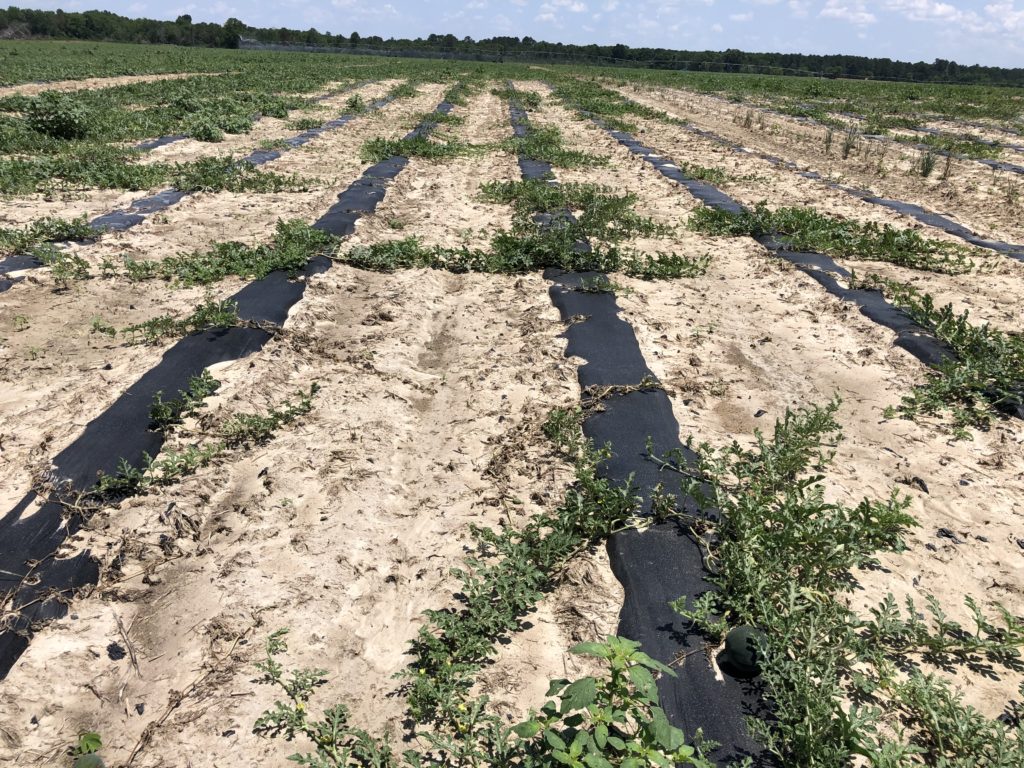By Bhabesh Dutta
Fusarium wilt has emerged as a chronic problem in watermelon-growing regions in the United States, including Georgia. The disease has been responsible for significant pre- and post-harvest losses in yield and quality. Fusarium wilt is caused by the fungal pathogen Fusarium oxysporum f. sp. niveum (FON).

DISEASE SYMPTOMS
In the field, symptoms typically start within two to three weeks after transplanting with greying and incipient wilting of foliage followed by permanent wilting and foliar necrosis. Unilateral stem necrosis is a characteristic symptom of fusarium wilt, which can be easily visualized when runners or stems are sectioned. In severely infected plants, fruit set may not occur, and plants often die prematurely.
Plants infected earlier in the season may display more severe symptoms later in the season, due to increased transpiration and stress. Stem cracking at the crown can also be observed due to profuse sporulation. Under conditions favorable for the disease, yield losses of more than 80% can occur.
MANAGEMENT STRATEGIES
In recent years, outbreaks of fusarium wilt have been economically damaging in watermelon. Several management strategies (including seed treatments, crop rotation, weed control and chemical management) are available, but in most cases, they are inadequate to manage FON epidemics.
In terms of chemical management, only prothioconazole (Proline) is registered for use against this pathogen. Limited benefits can be observed in fields with low levels of infestation. In heavily infested fields, current chemical management practices are not effective. Because of the destructive nature of this disease, watermelon growers in the southeastern United States often abandon once-productive watermelon fields after FON infestation.
Resistant commercial triploid cultivars are available against race 0 and 1. However, the presence of FON race 2 and potentially race 3 renders this strategy ineffective.
SURVIVAL AND SPREAD
FON infections are favored by temperatures of approximately 80 degrees and light, sandy, slightly acidic soils with high-to-moderate organic matter. Infection is delayed at temperatures above 91 degrees, often resulting in plants that are chlorotic and stunted but not wilted.
FON can survive as a saprophyte in soil and on plant debris for more than 10 years due to its ability to form thick walls. Pathogen propagules may be distributed through agricultural fields by soil, water, plant debris, infected transplants and farm equipment. FON is also transmitted by seeds and potentially infested through the pericarp and peduncle of immature fruit and pistils of watermelon flowers.

RESEARCH PROGRESS
With support from the U.S. Department of Agriculture National Institute of Food and Agriculture Methyl Bromide Transition Program, I have led a team of Extension specialists and county agents in conducting a study in Georgia. Independent trials were conducted as a part of a multiple series of trials over three years where impact of bed architecture and type of plastic mulch were evaluated on the efficacy of a fumigant (Pic-Clor 60) and reduction of fusarium wilt incidence. In addition, an integrated trial where a fumigant (Pic-Clor 60 at 300 pounds per acre), a non-fumigant nematicide (Nimitz at 5 pints per acre) and a post-transplant fungicide (Proline at 4.8 fluid ounces per acre) were integrated in different combinations to constitute high-input and medium-input treatments.
Results showed bed architecture did not increase the efficacy of fumigation (Pic-Clor 60), but the type of plastic mulch affected its efficacy. Irrespective of the bed architecture, plots with totally impermeable film had significantly lower fusarium wilt incidence compared with the plots with low-density polyethylene film. Disease incidence was based on both visual rating as well as vascular discoloration. Fusarium wilt incidence was significantly lower for the high- and medium-input integrated treatments compared with the grower’s standard treatment.
Our team is also evaluating options to optimize and facilitate adoption of watermelon-graft technology using the Carolina Strongback (CSB) rootstock for the management of fusarium wilt. Recent trials indicate that the grafted rootstock can significantly reduce fusarium wilt incidence compared with the non-grafted seedlings across all trial locations. However, the CSB rootstock is not immune to the pathogen and may get infected under heavy fusarium infection. However, the level of disease incidence will potentially be lower than the non-grafted rootstocks.
Currently, the team is evaluating if CSB rootstock is resistant to soil-borne pathogens (FON, Sclerotium rolfsii and Pythium spp.) that are prevalent in vegetable production fields in Georgia. The team is also evaluating if planting date and soil temperature would impact fusarium wilt incidence and severity in CSB-grafted watermelon seedlings.
Bhabesh Dutta is an associate professor and Extension vegetable disease specialist at the University of Georgia in Tifton.










